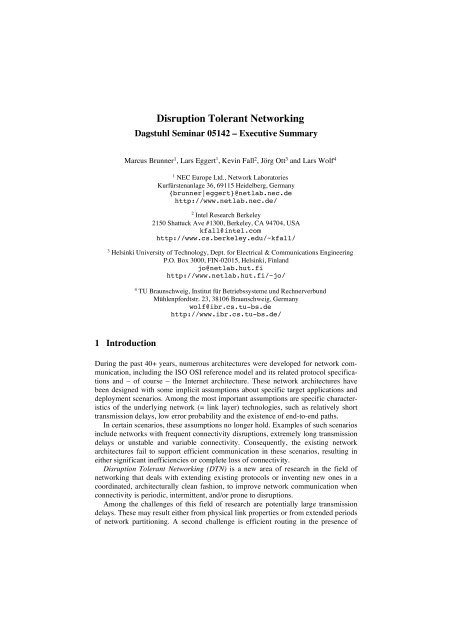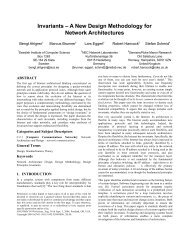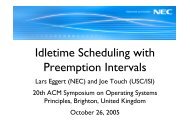Disruption Tolerant Networking - Lars Eggert
Disruption Tolerant Networking - Lars Eggert
Disruption Tolerant Networking - Lars Eggert
Create successful ePaper yourself
Turn your PDF publications into a flip-book with our unique Google optimized e-Paper software.
<strong>Disruption</strong> <strong>Tolerant</strong> <strong>Networking</strong><br />
Dagstuhl Seminar 05142 – Executive Summary<br />
Marcus Brunner 1 , <strong>Lars</strong> <strong>Eggert</strong> 1 , Kevin Fall 2 , Jörg Ott 3 and <strong>Lars</strong> Wolf 4<br />
1 NEC Europe Ltd., Network Laboratories<br />
Kurfürstenanlage 36, 69115 Heidelberg, Germany<br />
{brunner|eggert}@netlab.nec.de<br />
http://www.netlab.nec.de/<br />
2 Intel Research Berkeley<br />
2150 Shattuck Ave #1300, Berkeley, CA 94704, USA<br />
kfall@intel.com<br />
http://www.cs.berkeley.edu/~kfall/<br />
3 Helsinki University of Technology, Dept. for Electrical & Communications Engineering<br />
P.O. Box 3000, FIN-02015, Helsinki, Finland<br />
jo@netlab.hut.fi<br />
http://www.netlab.hut.fi/~jo/<br />
1 Introduction<br />
4 TU Braunschweig, Institut für Betriebssysteme und Rechnerverbund<br />
Mühlenpfordtstr. 23, 38106 Braunschweig, Germany<br />
wolf@ibr.cs.tu-bs.de<br />
http://www.ibr.cs.tu-bs.de/<br />
During the past 40+ years, numerous architectures were developed for network communication,<br />
including the ISO OSI reference model and its related protocol specifications<br />
and – of course – the Internet architecture. These network architectures have<br />
been designed with some implicit assumptions about specific target applications and<br />
deployment scenarios. Among the most important assumptions are specific characteristics<br />
of the underlying network (= link layer) technologies, such as relatively short<br />
transmission delays, low error probability and the existence of end-to-end paths.<br />
In certain scenarios, these assumptions no longer hold. Examples of such scenarios<br />
include networks with frequent connectivity disruptions, extremely long transmission<br />
delays or unstable and variable connectivity. Consequently, the existing network<br />
architectures fail to support efficient communication in these scenarios, resulting in<br />
either significant inefficiencies or complete loss of connectivity.<br />
<strong>Disruption</strong> <strong>Tolerant</strong> <strong>Networking</strong> (DTN) is a new area of research in the field of<br />
networking that deals with extending existing protocols or inventing new ones in a<br />
coordinated, architecturally clean fashion, to improve network communication when<br />
connectivity is periodic, intermittent, and/or prone to disruptions.<br />
Among the challenges of this field of research are potentially large transmission<br />
delays. These may result either from physical link properties or from extended periods<br />
of network partitioning. A second challenge is efficient routing in the presence of
frequently disconnected, pre-scheduled, or opportunistic link availability. In some<br />
cases, an end-to-end path may not even exist at any single point in time. From a mobility<br />
perspective, DTN relaxes the “always on” paradigm, which would be extremely<br />
costly or even impossible to realize in challenged environments. A third challenge is<br />
that high link-error rates make end-to-end reliability difficult. Finally, heterogeneous<br />
underlying network technologies (including non-IP-based internetworks) with very<br />
different communication characteristics may need to be embraced.<br />
These challenges can decrease the reliability and performance of communications<br />
at essentially all layers of the protocol stack, ranging from packet-based forwarding<br />
and routing, to reliability and other features provided at the transport layer, to the<br />
application protocols (and applications) themselves. The possibly resulting high<br />
transmission delays, errors rates, and the lack of an end-to-end path require different<br />
approaches to application interactions, reliability and security mechanisms. In addition,<br />
traditional mobility approaches may have to be revisited to accommodate users<br />
in networking environments prone to connectivity disruptions.<br />
2 Seminar Topics<br />
Numerous research activities over the past three years have focused on various facets<br />
of communications in challenged environments. Architectural concepts have been<br />
devised, prototype implementations were developed and research results are available<br />
from analysis, simulations and real-world experiments. The Dagstuhl seminar brought<br />
together researchers working in otherwise at least partly disjoint areas and established<br />
an intense dialogue across the variety of application domains.<br />
A key realization of the seminar was that most participants mainly worked in the<br />
scope of one of two general areas of disruption tolerant networks. One group of participants<br />
is investigating solutions for networks with extremely long communication<br />
delays, such as the Delay-<strong>Tolerant</strong> <strong>Networking</strong> Architecture investigated within the<br />
Delay-<strong>Tolerant</strong> Research Group (DTNRG) in the Internet Research Task Force<br />
(IRTF). These new approaches often build on the paradigm of asynchronous interactions<br />
and introduce additional inter-internetworking layers that spawn multiple, specialized,<br />
internetworks of different characteristics.<br />
Into this first group or presentations fell Bengt Ahlgren’s talk on applications for<br />
asynchronous networking, Ben Hui et al.’s talk on “pocket-switched” networks and<br />
Srinivasan Keshav’s extensions to the DTNRG architecture.<br />
A second group of participants focused on approaches for improving Internetbased<br />
communication in scenarios where connectivity disruptions are frequent. Although<br />
this case can be generalized to the former – a connectivity disruption can be<br />
seen as a long communication delay – the dynamic change from short to long communication<br />
delays when a disruption occurs deserves special consideration, especially<br />
because communication efficiency should remain close to current Internet levels<br />
when connectivity is present and delays are short. This second group of presentations<br />
included Marc Bechler’s and Holger Füßler’s different protocol modifications for<br />
vehicular ad hoc networks, Simon Schütz’s TCP modifications for disrupted access<br />
links, Carsten Bormann et al.’s talk on “near end” DTN solutions, Aaron Falk’s pres-
entation on military satellite communication, Dirk Kutscher et al.’s talk on “Drivethru”<br />
Internet access and Lavy Libman’s disruption prediction for public transportation,.<br />
Finally, a third group of presentations was orthogonal to this division. They include<br />
Per Gunningberg’s experimental testbed for DTN solutions and Hannes Tschofenig’s<br />
security considerations for DTN.<br />
3 Research Questions<br />
One major open question is whether the two areas of work described above – research<br />
related to DTNRG’s bundle-based long-delay architecture on one hand and modifications<br />
to extend current Internet protocols for disruptive environments on the other<br />
hand – are in the end similar enough to be pursued within a combined effort. Although<br />
there are significant overlaps in mechanisms and approaches, the base characteristics<br />
and supported applications differ. Whereas the DTNRG and its related work<br />
focus on scenarios that may never support interactive applications, the main focus of<br />
the latter approaches is to improve the operation of existing, interactive Internet applications<br />
and protocols in situations where network connectivity is intermittent.<br />
One challenge with improving Internet functionality is that the design options are<br />
limited, because of the need to remain compatible with deployed infrastructure and<br />
applications. The DTNRG architecture, on the other hand, has no such restrictions,<br />
because legacy applications are simply unsupported. Consequently, the designers of<br />
DTNRG-related mechanisms are free to evaluate and adopt name/locator, security or<br />
signaling mechanisms that cannot be used in approaches that extend traditional Internet<br />
protocols due to compatibility problems.<br />
Specific questions arose around the issues surrounding whether modifications of<br />
only TCP (called various “TCP hacks”) are an adequate solution to a subset of the<br />
problems of DTN. Although this may be useful for some situations, extended outages<br />
(including those that may span a system reset) will probably not be adequately addressed<br />
solely based on such modifications. Nonetheless, such modifications may<br />
operate in concert with other techniques in addressing more severe disruptions.<br />
The DTNRG has been working on an architecture designed to accommodate a very<br />
wide range of network types, including those with potentially very long delays. The<br />
question was raised as to whether it is realistic to believe this architecture will truly be<br />
able to span such a large variety of networks. It would seem evident that further experience<br />
with the DTNRG architecture may help to answer this question. It may be<br />
instructive to recall, as well, that the Internet architecture has been adopted by a very<br />
wide range of network types and performance characteristics.<br />
The DTNRG architecture generally provides routing based on names, represented<br />
as some form of string. The question was raised as to the difference between names<br />
and addresses. When addresses are not derived from a numbering space that is tied to<br />
the network topology (e.g., cell phone numbers that can roam), names and addresses<br />
can be considered to be effectively equivalent.<br />
Some discussion focused on the issue of how to provide security in networks of<br />
this kind. Most systems, including PKI schemes, are made even more difficult to
deploy due to the inability to obtain network credentials on demand. Although there is<br />
interest in identity-based cryptosystems, this is nascent and the experience with such<br />
systems is fairly limited.<br />
In systems with mixed traffic (i.e., that may include asynchronous traffic along<br />
with quasi-synchronous traffic), some facility for indicating the quality-of-service<br />
requirements associated with the data may be important. The issue of signaling for<br />
this purpose (and possibly others) remains largely unexplored. It was noted that the<br />
general problem of signaling has gone in and out of IETF over the years (partly in the<br />
form of middle-box communication), but that it still remains out of standardization.<br />
In summary, this Dagstuhl seminar has sharpened the understanding of the very<br />
different perspectives from which researchers approach the problem space of disruption-tolerant<br />
networking, their assumptions and requirements, and the short- and longterm<br />
solutions they envision. This has broadened the view on DTN at large and contributes<br />
further issues to the present DTN research topics such as naming, security,<br />
service differentiation and efficiency. Assuming the traditional well-connected Internet<br />
architecture and its (interactive) applications as one extreme and the DTNRG<br />
architecture for purely asynchronous communications as another, the middle ground<br />
of mobile and partly (dis)connected operation may be approached from either edge.<br />
Future research will need to determine how far the DTNRG architecture can and<br />
should reach towards traditional Internet applications while maintaining its architectural<br />
integrity.





